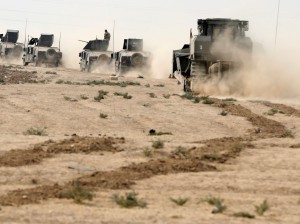In coming months, the Islamic State will lose its strongholds of Mosul and Raqqa in Iraq and Syria. Yet evicting the group from these cities alone will not be sufficient in stopping future attacks or deterring its military capabilities since the self-proclaimed caliphate will still govern a wide swathe of key Syrian territory. The international coalition must prioritise retaking this land if it hopes to defeat the Islamic State once and for all.
After Raqqa’s fall, the Islamic State will retreat to Syria’s vast and overlooked Deir Ezzor province where it is already well entrenched. This arid stretch of eastern Syria straddling the Euphrates river valley has so far failed to get the attention from policymakers it deserves.
The “time of wilderness” experienced by the Islamic State’s predecessor group offers an instructive lesson. In 2007, the US boosted its troop numbers Iraq as part of its surge strategy. It buffeted these forces by enticing Sunni tribal leaders in the western Anbar province, many of whom were disgusted by the then Islamic State of Iraq’s savage tactics, to buy in. While this booted the militants from their Anbar strongholds and diminished their numbers, surviving fighters subsisted for years in hard-to-reach corners of Iraq, eventually re-emerging as an even more powerful foe.
Deir Ezzor and its village belts and mid-sized towns is more than a wilderness – it is an enormous hinterland. Here, Islamic State can reorganise, refit and reassert itself following losses in northern Syria and Iraq. Just as the group slowly mushroomed from a handful of worn-out guerillas into a more conventional fighting force between 2008 and 2011, so too it may use Deir Ezzor and its obscure villages as shelter.
It has already fashioned Deir Ezzor into a fortress. Only a sliver of Deir Ezzor city, the provincial capital, and its adjacent air and military bases remain under Syrian regime control. Many of the city’s inhabitants cut off from the outside world by strict siege. The Islamic State wields total control in its countryside, and in towns like al-Mayadeen, al-Bukamal and the Iraqi border town of al-Qaim those who have dared challenge its authority have met gruesome fates. To secure its position the Islamic State has either roped the local tribes of the Euphrates river valley into its fold or cowed them into submission through brute force.
Syrian activists have also reported that the Islamic State is preparing to transfer some of its senior leadership to the province. The killing of top-tier commander Abu Sayyaf at the hands of American special forces soldiers in a major Deir Ezzor oil installation in May 2015 suggests that the presence of leadership in the region is nothing new.
From Deir Ezzor the Islamic State can continue to mount conventional military operations. This could mean trying to seize the regime airbase, and push into the soft underbelly of the Syrian regime in eastern Homs, or spearheading toward Palmyra and its nearby oil fields. The Deir Ezzor pocket will continue to afford the Islamic State a springboard for guerilla or conventional attacks. To prevent the Islamic State from surviving as a rural insurgency, the international coalition must hunt the terror group into the depths of this desert flank.
The Syrian regime lacks the manpower and the operational capability to retake Deir Ezzor, even with the backing of Russian airpower. Likewise, Iraqi prime minister Haider al-Abadi has poured cold water on the notion that Iraq’s popular militias enter the Syrian theatre. Should they defy him and try, an advance by the mostly Shia militias could upend eastern Syria’s ornate social fabric and add fuel to the sectarian fire.
The international coalition’s current battle plan for Raqqa, focusing on using mostly Kurdish militias to retake majority-Arab territory, inspires little confidence. This ethnic mixture could sow seeds for future conflict. Instead of replicating this, the coalition should entice Euphrates river valley tribes and other Sunni Arab opposition forces to push on Deir Ezzor. In other words, they should mimic the 2007 Anbar recipe for success.
If successful, an opposition-held eastern Syria could also pressure the Russians – and by extension the Syrian regime – into a tighter bargaining position. The regime would be forced to accept opposition control over the Iraqi border and the core of the country’s oil and gas infrastructure. This could open the door for a more earnest attempt at a negotiated multilateral settlement. It would remove the Islamic State as a variable in east Syria, give the opposition much-needed safe haven, and force the regime and its backers to accept the limits of their force projection.
The fight against the Islamic State will continue long after Raqqa and Mosul’s liberation. The US should not yield in its determination to pursue the terror group to the farthest stretches of Syria. If it fails do so, the Islamic State may just re-emerge once again, revitalized and born anew as it has before.
Ignoring Deir Ezzor means ignoring a key piece of the Syrian tapestry. It is only by recapturing Islamic State-held territory in its totality, including these desert flanks and fringes, that the US and allies can hope to put the final nails in its coffin. Until then, Deir Ezzor will remain the missing piece in the puzzle of destroying the Islamic State.
newstatesman.com



